

Jon Clements, Author (unless otherwise noted) and Editor
Current degree day accumulations
| UMass Cold Spring Orchard, Belchertown, MA |
4-July |
| Base 43 (SkyBit) | 1643 |
| Base 50 (NEWA) | 1041 |
Note: this will be the last current degree day accumulations for 2016
| Coming events | Degree days (Base 43 BE) |
| Apple maggot 1st catch | 1249-1663 |
| Apple maggot 1st oviposition punctures | 1605-2157 |
| Codling moth 2nd flight start | 1571-2245 |
| Dogwood borer flight peak catch | 1462-1878 |
| Lesser appleworm 2nd flight start | 1412-2090 |
| Obliquebanded leafroller 1st flight subsides | 1619-2045 |
| Oriental fruit moth 2nd flight peak | 1444-1960 |
| Peachtree borer 1st catch | 799-1331 |
| Redbanded leafroller 2nd flight peak | 1528-1986 |
| San Jose scale 2nd flight start | 1629-1979 |
| STLM 2nd gen tissue feeding mines present | 1378-2035 |
*adapted from Scaffolds Fruit Journal
Key insect life cycle and management dates (and some disease and horticuluture stuff)
Note: for 2016, we have five Massachusetts orchard locations subscribed to AR: Belchertown, Easthampton, Deerfield, Groton, Phillipston, and Sutton. The website for looking at AgRadar for these locations is: http://extension.umaine.edu/ipm/ag-radar-apple-sites/. What follows is for the Belchertown location.
Apple Maggot Fly (AMF) -- Rough guess of date first apple maggot flies are caught on traps is: Tuesday, June 28. Rough guess of peak AM trap captures is: August 2, Tuesday.
Dogwood Borer (DB) -- first egg hatch roughly: June 19. Peak hatch roughly: July 26
Codling Moth (CM) -- Codling moth development as of July 5: 2nd generation adult emergence at 0% and 1st generation egg hatch at 96%. 2nd generation 7% CM egg hatch: July 24, Sunday, = target date for first spray where multiple sprays needed to control 2nd generation CM. 2nd generation 30% CM egg hatch: August 3, Wednesday, = target date where one spray needed to control 2nd generation CM.
Obliquebanded Leafroller (OBLR) -- Optimum sample date for late instar summer generation OBLR larvae: June 29, Wednesday If first OBLR late instar larvae sample is below threshold, date for confirmation follow-up: July 3, Sunday.
Oriental Fruit Moth OFM -- 2nd generation OFM flight begins around: June 25, Saturday. 2nd generation - first treatment date, if needed, July 2, Saturday. 2nd generation - second treatment date, if needed: July 13, Wednesday.
Redbanded leafroller (RBLR) -- 2nd RBLR flight begins around June 26, Sunday. Peak catch and approximate start of egg hatch: July 8.
Spotted Tentiform Leafminer STLM -- 2nd STLM flight begins around: June 14, Tuesday. Rough guess of when 2nd generation sap-feeding mines begin showing: July 2, Saturday. Optimum first sample date for 2nd generation STLM feeding mines is July 8, Friday.
Preliminary McIntosh Harvest Date Forecasts -- Date to apply ReTain to delay first harvest for apples which without treatment would be ready for storage harvest on September 3 is from Saturday August 6 to August 13. Date to apply ReTain to delay maturity for 2nd, 3rd or 4th pick of those apples, without delaying start of harvest maturity, is from Sunday, August 20 to August 27. Begin measuring actual McIntosh starch-iodine index no later than Wednesday, August 17. The Michigan formula estimates that non-spur McIntosh will reach starch index 4.0 and start the optimum harvest window for long term storage on Saturday, September 3. Using the Champlain Valley NY formula, McIntosh maturity is forecast to reach starch index 6.0 in Belchertown MA on Wednesday, September 14.
13-July, 2016 (Wednesday). Massachusetts Fruit Growers' Association Summer Meeting, UMass Cold Spring Orchard, 391 Sabin Street, Belchertown, MA. 10 AM to 2:30 PM For more information and to pre-register (by July 11 please!): http://massfruitgrowers.org/2016/2016summermeeting.html.
19-21 July, 2016. International Fruit Tree Association New York Study Tour. For more information: http://www.ifruittree.org
For more information and updates, see Upcoming Events
Jon Clements
Really what should be on our minds is how dry it has been and how it might affect the crop. No peaches to worry about, but certainly apples are under some stress and have started to set terminal buds. Apples are pretty resilient, but need some moisture to grow and size fruit. I was beginning to question the need for irrigation as the last several years have seen plenty of moisture, but now many orchards are under a "moderate drought" status. This can't be good. Now I am convinced, that in addition to deer fence, trickle irrigation is a !!must-have!!! in any new orchards going in the ground. Thanks to Tom Smiarowski, UMass Risk Management/Crop Insurance Education program, for compiling the June precipitation info below.
Hope to see you at the MFGA Summer Meeting on July 13 at the UMass Orchard in Belchertown. Please pre-register (by Monday, July 11!) here.

Elizabeth Garofalo and Jon Clements
• Potato leafhopper (PLH) are here for sure, right on time. Threshold for tolerance is ZERO in new plantings, consult NETFMG (or below) for treatment options, many insecticides are effective, however, Assail, and imidacloprid would be good "softer" (i.e., beneficial insect-friendly) options.
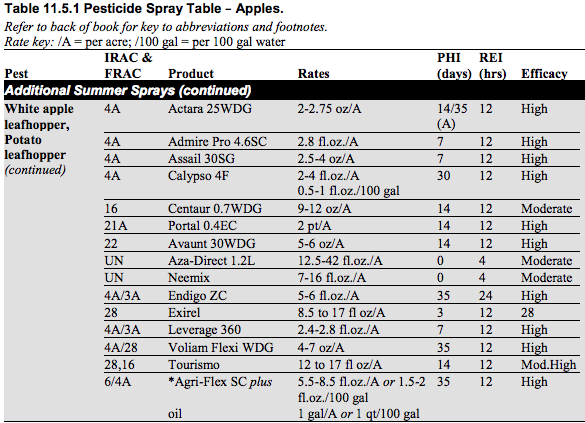 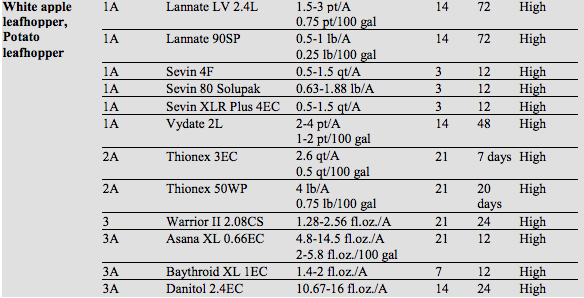 |
 "Nasty" little potato leafhopper bugger causes "hopper burn." Photo taken 6-July, 2016 by Jon Clements at UMass Orchard, Belchertown, MA "Nasty" little potato leafhopper bugger causes "hopper burn." Photo taken 6-July, 2016 by Jon Clements at UMass Orchard, Belchertown, MA |
• Obliquebanded leafroller (OBLR) scouting can commence. For procedure, and action, as excerpted from http://www.omafra.gov.on.ca/IPM/english/apples/insects/oblr.html#advanced
Thresholds
Management for the summer generation is recommended if 1% to 2% of terminals or fruit/blossoms are infested. Resample the orchard in three to five days to ensure the population was not underestimated. Once the threshold of 1% to 2% of terminals or fruit are infested, an insecticide is recommended. Follow up sprays may be required because of the extended larval emergence of the summer generation (four to five weeks).
And, consider this from Peter Jentsch's latest blog post:
At this point in the season we are nearing the end of obliquebanded leafroller (OBLR) emergence. The majority of 1st instar nymphs have hatched from egg clusters and are now developing into larger larva. In untreated apple, foliage and fruit feeding will become more evident over the course of the week. In orchards with historic OBLR damage, growers controlled the larval emergence this season beginning in early to mid-June, making two applications for the summer generation at 14 to 21 day intervals. Approximately 90% OBLR hatch occurred @ 810 DD43 (23rd June) with 1035.7 DD43 accumulations as of July 2nd in Highland, representing nearly 100% hatch. The residual of two applications during hatch using effective insecticides have been shown to reduce the OBLR through emergence. With relatively little in the way of rainfall this season , residual activity should have been excellent.
And finally, from Scaffolds Fruit Journal this week:
Obliquebanded Leafroller According to our developmental models, the first summer brood hatch should be anywhere from 50–100% complete around the state this week. Orchards with historically high OBLR pressure should normally receive an application of a suitable material during the first part of July, so this week would be the latest possible time for such an application against the larvae of this brood if they haven't been attended to. Delegate, Altacor, Belt, Exirel, Rimon and Proclaim are appropriate choices, particularly in cases where the larvae are a bit larger, and a B.t. product such as Dipel, or else the IGR Intrepid are also options, but these tend to be more effective when applied against the earlier stages. If you are applying any of the diamides (Belt, Altacor, Exirel) or Delegate to control codling moth and oriental fruit moth, they will also be very effective against OBLR at this time. Regardless, we have found that this specific spray is the most critical for preventing fruit-feeding damage at harvest, so put this at the top of your list of priorities if OBLR has distressed you in the past.
• Apple maggot fly (AMF) are emerging, although these first flies don't demand treatment. But for the first insecticide spray, where and when necessary, consult the NETFMG for recommendations.
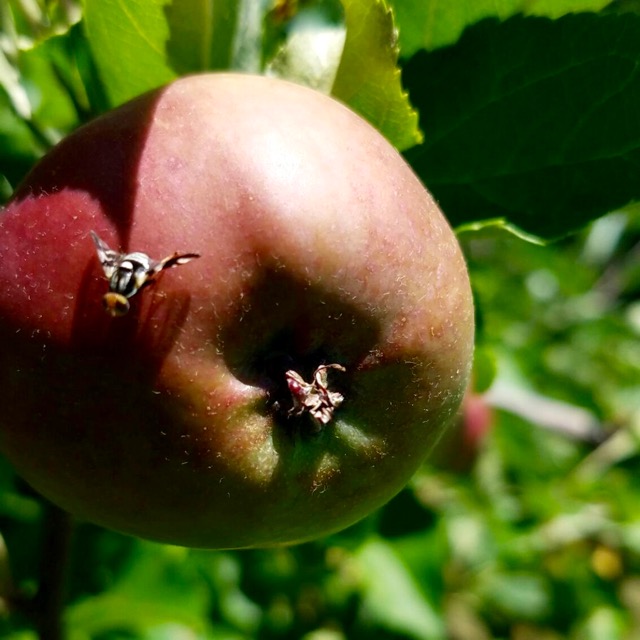
Apple maggot fly on apple in central Massachusetts orchard 30-June, 2016.
Submitted by to remain anonymous apple grower, thanks.
• Japanese beetles (JB) are not numerous (yet) but out there. See Peter Jentsch's latest blog post on this subject for details on this little beast. As a fact, they prefer Honeycrisp foliage, so check those trees first for signs of JB. Treatment options as listed in the 2015-16 NETFMG are:
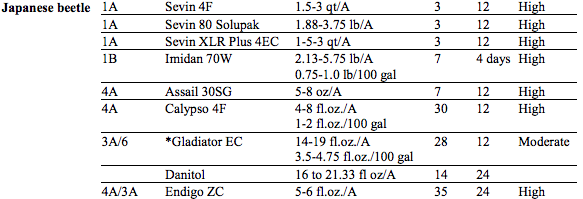
Dan Cooley
Fungicides needed? At this point in the season it is clear whether or not scab has started in apples. If you’ve looked and aren’t seeing any in the places where it’s most likely, then chances are there is none. While we have plenty of scab visible for a month on trees that were not sprayed in a high inoculum block, where we sprayed scab incidence is very low particularly on the few fruit we have.

Established scab
It was a relatively easy scab year. The one major infection event hit May 1 and went on for several days. There were three other significant scab infections in May, but nothing close to the wet week of May 1.
.
The 2016 primary apple scab season at the Hort. Research Center as modeled by RIMpro. The higher the red
lines go, the higher the infection risk. In a “clean” orchard, a RIM Infection Value of 300 is considered the
threshold for a significant infection.
So, if there’s no scab in an orchard, why spray fungicides in the summer? There are other fungal diseases, primarily sooty blotch/flyspeck, powdery mildew, and fruit rots. But this lawn-burning drought weather is unlikely to put much pressure on for these diseases, with the possible exception of mildew. For those of you thinking it might be nice to grow apples in Yakima, Yakima has come to you.
There simply hasn’t been enough wet or even humid weather to push SBFS along. While we might get some wet weather towards the weekend, it would be a good thing. It still won’t make it important enough to apply a fungicide for SBFS. While we know less about the amount of rain needed to cause infections, black rot, bitter rot and white rot probably haven’t had a chance to get started either.
If you think maybe mildew is a problem to be sprayed, check your most susceptible trees: Cortland, Ginger Gold, Idared, Paulared and Rome are relatively more susceptible varieties. Unless you see a problem, it’s probably not worth a spray.
Which means, I think, that you can take advantage of the Yakima-like climate and forget about fungicides for at least a couple of weeks.
Shoot (fire) blight. Some growers have been pruning out shoot blight. These infections probably got started back in late May. At this point, the only thing to do is prune out the infections as they appear. Do not apply streptomycin! If you really want to spray, then you could try Cueva or Mastercop plus Double Nickel. This may russet fruit, but has shown promise in stopping shoot blight infections.
Do prune out the blight as soon as you see it. When pruning fire blight, the best method to use is the “ugly stub” approach. Make cuts into wood that is at least two years old. Two-year-old wood is more resistant to fire blight than one-year wood, and can slow or stop infection movement in the tree. Fire blight bacteria travel well ahead of visible infection, so cut at least 18 inches below visible infections. Cutting back to a 4 to 6 inch naked stub in two-year-old or older wood allows the tree to use its own resistance to isolate disease in the stub.
Inevitably the fire blight bacteria will form a canker an inch or two in from a cut surface. Sterilizing tools will not stop this, so it is not worth the effort. As a result, if a flush cut is made back to the branch collar, the resulting bacteria colonization and canker will form an inch or two into the next limb or in the trunk. By leaving a stub, the canker forms in it, and the stub can be cut off with the canker during the next winter.

Shoot blight on new shoot, with a small orange drop of bacterial ooze on the shoot
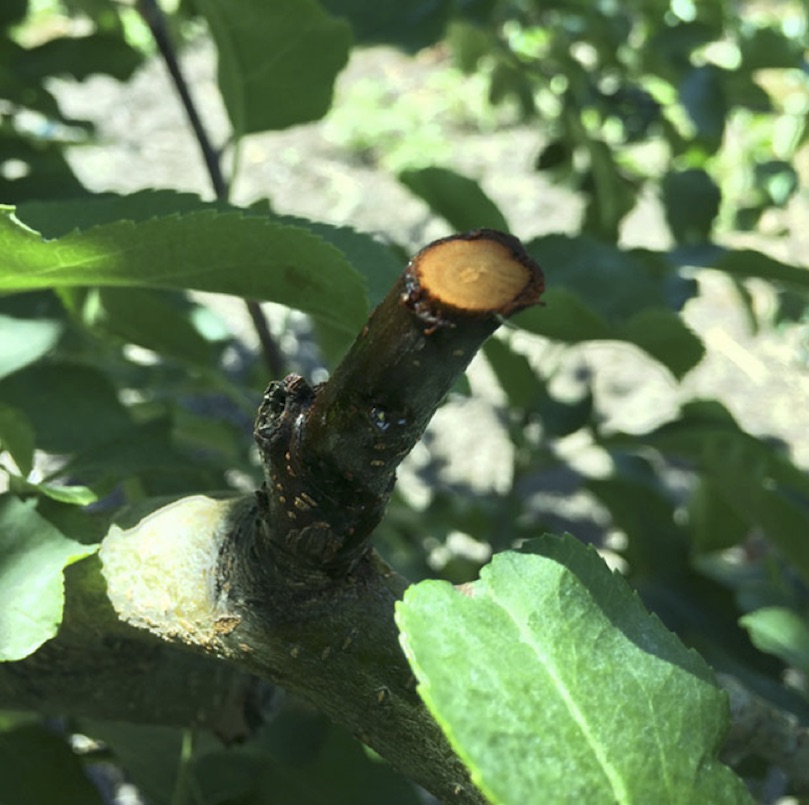
An ugly stub cut. The tissue is still producing ooze, but hopefully the tree will be able to wall off the
infection before it reaches the next branch.
J. Clements
• I'm still hand-thinning apples, doing a little touch-up pruning, spot-treatment of weeds with herbicides, irrigating, tying trees to wire, etc., etc. Calcium and return-bloom sprays ongoing. Things look pretty good but fruit set is way too variable. McIntosh fruit clusters are particularly difficult to hand-thin. (It's way too easy to hate McIntosh sometimes.)
• No Guest article this week...

Follow me (jmcextman) on FB: https://www.facebook.com/jmcextman

• No YouTube video this week.
UMass Fruit Advisor: http://umassfruit.com
Scaffolds Fruit Journal: http://www.nysaes.cornell.edu/ent/scafolds/
Network for Environment and Weather Applications (NEWA): http://newa.cornell.edu
Follow me on Twitter (http://twitter.com/jmcextman) and Facebook (http://www.facebook.com/jmcextman)
The next Healthy Fruit will be published on Tuesday, July 12 (or thereabouts), 2016. As always feel free to get in touch with any member of the UMass Fruit Team (http://extension.umass.edu/fruitadvisor/team-members) if you have questions or comments.